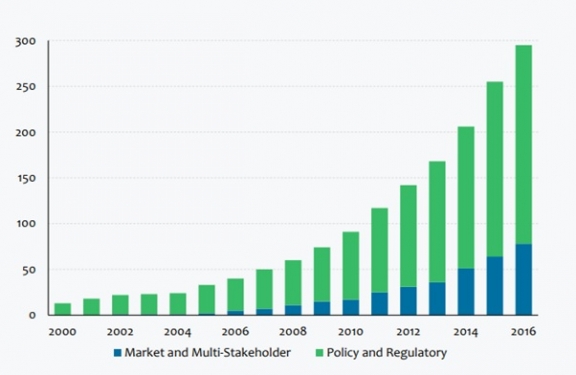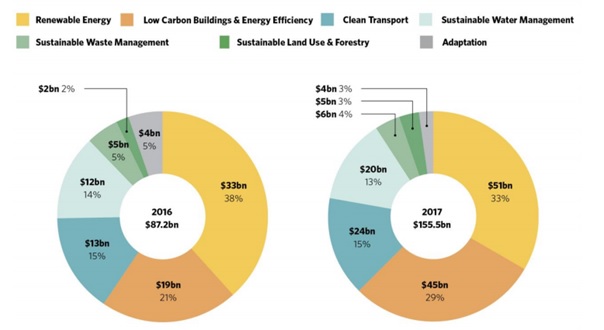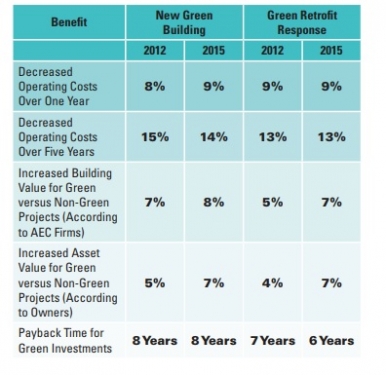
The real estate sector’s green finance gap
In 2016, against the backdrop of the Paris Agreement and United Nations Sustainable Development Goals, G20 member countries committed to raising the US$90 trillion required to achieve the global sustainable development and climate objectives by 2030. These countries, acknowledging that they produce about 80% of global climate-changing greenhouse gas (GHG) emissions, also recognized that more public and private financial support – or green finance – is needed for low carbon and climate resilient development.
Green finance is the capital raising and financial investment put forth for projects, products and companies to achieve inclusive, resilient and sustainable development. The momentum of green financing is reflected by the rising number of policy and regulatory measures, as well as market and multi-stakeholder initiatives. In mid-2016, UNEP identified over 200 of policy measures related to the green financial system across 60 countries, which represents 74% of all sustainable finance measures. Separately, there were nearly 80 collective initiatives from market institutions, including financial institutions and stock exchanges, as well as multi-stakeholder initiatives such as UNEP Finance Initiative.
 Figure 1: The global evolution in measures for sustainable finance 2000-2016 (Source)
Figure 1: The global evolution in measures for sustainable finance 2000-2016 (Source)
Green finance landscape in China and Hong Kong
Of all G20 countries, China is at the vanguard of green finance and has established a robust 35-point green financial system guideline that links with the all seven G20 Green Finance Study Group options. According to the Climate Bonds Initiative, China is the second biggest green bond issuing country after the United States, with China Development Bank being the second largest cumulative bond issuer in 2017.
Announced in their Budget 2018-2019, the HKSAR Government is planning to launch a HK$2.5 million (US$319,428) three-year pilot bond grant scheme to attract more first-time corporate issuers from China and the 60 plus countries covered by the Belt and Road Initiative. Also, a green bond issuance programme with a borrowing ceiling of HK$100 billion (US$1.3 million) will be launched to provide funding for green public works projects of the Government.
Why green finance is crucial for Hong Kong’s real estate sector
Energy use in buildings and the construction sector represent more than one-third of the world’s energy consumption and contributes to almost one-quarter of GHG emissions. Given the importance of buildings in relation to climate objectives and economic benefits, investment in green building is growing worldwide. Though investment in renewable energy continues to be the most common, allocations to low carbon buildings and energy efficiency rose 2.4 times year-on-year and accounted for 29% use of global green bond proceeds in 2017.
 Figure 2: Global use of green bond proceeds distribution (Source)
Figure 2: Global use of green bond proceeds distribution (Source)
As one of world’s most densely populated cities, Hong Kong’s commercial and residential buildings accounted for 64% of the Hong Kong’s total energy consumption with 90% of the total GHG emissions stemming from energy consumption alone. By 2046, about 47% of Hong Kong’s buildings will be 70 years old or above, which is expected to result in an unsatisfactory energy performance by current standards. To combat this, the HKSAR Government has set a reduction target for carbon intensity of 65-70% by 2030, as compared with 2005. The current decarbonization efforts are only expected to reduce carbon intensity of around 50% by 2020, which is far from 2030 target. To achieve the target, significant efforts needs to be put into green building development for both new and existing buildings.
Apart from achieving national and local climate objectives, green buildings can bring multiple business benefits. According World Green Building Trends 2016, architects, contractors, consultants, developers and engineers in 69 countries reported that new green buildings and green retrofitted buildings bring a 9-14% decrease in operating costs over a one to five-year timeframe, while increasing building and asset values by 8% and 7% respectively (as shown in Figure 3).

Figure 3: Business benefits expected from green building investments – median reported in 2012 and 2015 (Source)
In Hong Kong, among 452 BEAM Plus certified new building projects, projects with BEAM Plus rating Bronze or above typically achieve 16-21% energy reduction annually. Despite the obvious operational cost savings, a hurdle developers have to bear to attain this comes from the associated higher initial capital costs that come with green building ratings, which limits green building development to developers with deeper pockets.
Green bonds can be a powerful tool that could help Hong Kong become a greener metropolis while transforming new and existing buildings into green buildings. Green bonds could cover some of the upfront construction and retrofitting costs needed to make this transformation a reality. Although green bonds have some additional transaction costs for tracking, monitoring and reporting on use of proceeds, the Climate Bonds Initiative indicates that many issuers, especially repeat green bond issuers, have found the initial costs are offset based on the benefits listed below. In short, green bonds can help a company:
- Highlight their green assets/business
- Create a positive marketing story
- Diversify their investor base (as they can now attract investors who are environmental, social and governance/responsible investing specialists)
Financing green buildings in Hong Kong
Currently, green building financing in Hong Kong is market-driven. In July 2016, Link Real Estate Investment Trust was the second green bond issuer (after Goldwind, the first green bond issue in China which is also listed on Hong Kong Stock Exchange) in Hong Kong to launch a green bond. The proceeds of the US$500 million bond were used to increase investment in three major categories of projects across its portfolio; green building development, renovation of existing buildings and energy efficiency projects. More recently, Swire Properties issued its own bond that priced US$500 million for funding or refinancing the company’s new or existing green projects. These include green building development, energy efficiency, renewable energy, sustainable water and wastewater management. New World Development raised its first green loan of US$459 million to fund Hong Kong a green commercial re-development project. The project has already achieved the world’s first WELL Building Standard Pre-certification (Platinum), as well as BEAM Plus New Buildings (Provisional Platinum) and LEED Building Design and Construction Core and Shell Pre-certification (Platinum).
Despite the environmental and economic benefits achieved by energy savings in green buildings, green bond funded projects only represent a very small number of development projects in Hong Kong. There is huge potential for green financing for new and existing buildings, as seen in other countries which have implemented various green finance initiatives that Hong Kong could emulate:
- Singapore’s Building and Construction Authority introduced a Building Retrofit Energy Efficiency Financing Scheme that enable building owners to receive bank loans to retrofit their buildings to meet Singapore’s green building standard “Green Mark.” Building owners can pay back the loan through the earned energy savings.
- The World Bank co-financed US$100 million with the Bank of Shanghai and SPD Bank to support building retrofits and near-zero carbon buildings in Shanghai.
- Maanshan Rural Commercial Bank in China repositioned itself as a green commercial bank. The bank now offers interest rate reductions for EDGE certified buildings.
While the market has started the green building financing and the HKSAR Government has announced pilot bond grant scheme and sovereign green bond issuance, there is still a long way to go before Hong Kong reaches it potential in green financing.
Contact CSR Asia if you are interested in learning more about green finance and how to make your company and your green building projects attractive to investors.
Image source: https://www.dreamstime.com/royalty-free-stock-images-green-wallstreet-finance-chart-image4892779